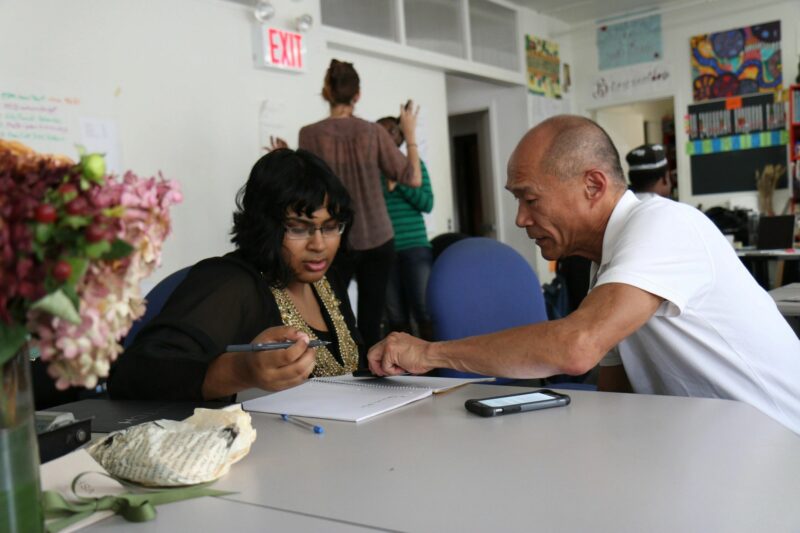
Daquanna L. Harrison
Elevation Educational Consulting Group
ABSTRACT
In How to Achieve Better Student Retention in Adult Education, by Teddy Eduoard (2019), teachers and administrators get an easy read with short, to-the-point chapters that are full of solutions! Unlike many education books, that are too long for already busy educators, this book gives you chapters that draw you in such as “Understanding Our Calling” and “Identifying the Warning Signs,” not to mention a facilitation guideline that could be used by administrators as an observation tool. As our field turns more to test results and workforce outcomes, we need this book as a reminder of the intricacies, obstacles, and real-world needs of our real-world learners. This book is great for veteran teachers who need a boost and new teachers who need to know that they are not simply doing a job: They are making relationships that can influence their learners for years to come.
INTRODUCTION
It is rare to have leadership development books written for the adult education (AE) field, rarer still to have such a book written by someone truly invested in the field, not just repurposing a K-12 book to get sales within the adult ed field. In How to Achieve Better Student Retention in Adult Education: Secrets to Becoming an Indispensable Adult-Ed Teacher That Provides a Learning Experience That’s Hard to Walk Away From (and Keeps Administrators Happy!) (Eduoard, 2019), educators in our field get a book that speaks to their day-to-day struggles and triumphs in a way only a colleague and leader in AE could illustrate. Having been at the teacher, program manager, and director/administrator level of many different types of AE programs, it was refreshing for me to find a nugget of knowledge for every audience. Be it teaching tips, program design ideas, or the “Facilitation Guidelines” (which in my opinion could be easily converted into an observation tool for directors looking to find and define the great work occurring within the classrooms), it is all here.
Below I highlight some of the major strengths of this book, but as a reviewer I want to give one warning: Edouard writes this book as if he is there talking to the reader and makes the (good) assumption that the reader is an educator who is already doing a great job in the classroom, who is in this field for all the right reasons, and who has a passion for the art and craft of teaching in the AE field. If this does not describe you, you may find yourself questioning your field of choice. You may feel out of place when he speaks to methods of engagement or certain teaching practices as if we are all “students and masters” of teaching; however, I suggest to you that you may be just the educator who needs this book. This book asks the reader to assume a posture of confidence and passion in their teaching and to not simply “pass through” these AE programs and learners’ lives. To press this point, Edouard starts the book with a George Washington Carver quote, “No individual has any right to come into the world and go out of it without leaving behind him distinct and legitimate reasons for having passed through it” (p. 5).
RETENTION
While the book is not broken down into the three R’s of retention, relationships, and real-world, it could easily have been written as a series under those three themes. Edouard provides tangible retention methods such as, “provide learners with tools to help them keep track of their attendance” (p. 31), which must be noted as advice stemming from restorative practices. Yet, it is in the intangibles that the true teaching gems lie. Stories stemming from a range of places from the football field to Silicon Valley are interwoven not only to provide examples of leadership, but to break down the silos that so many AE professionals find themselves in without even noticing. Throughout the book, retention seems to refer not only to learners but to educators as well. Edouard gives encouragement and examples that are meant to remind educators of why they are in this field and why their best is needed as a critical component of learner retention and perseverance. Starting the book with the educator in mind puts forth the correct expectation that retention starts with the educator understanding that their job should be a “calling.” As Edouard puts it, our true calling as adult educators is “about making real change happen so that we make things better for the students we serve” (p. 6). Those outside of the classroom would be smart to use this book as a staff development and enrichment tool.
RELATIONSHIPS
This is the big R…Relationships! Edouard puts a strong focus on all of the types of relationships, including the learners’ relationships to the teacher, content, environment, and classwork. He speaks to the importance of giving voice to learners and checking in with them as a way to build relationships. The teacher’s relationship to retention is highlighted by the title of Chapter 2, “Taking Matters into Your Own Hands.” In this and other chapters, Edouard inspires teachers to understand that it is up to them to create a system which leads to relationships and, then, retention. Through innovative writing techniques such as lists of warning signs and even a “list of lies,” Edouard has provided teachers multiple roadmaps and ways to connect to learners that build relationships that go beyond simply knowing a learner’s interest or desired job.
REAL-WORLD
When you see “real-world,” I am sure what comes to mind are examples stemming from work or life, and, yes, that is part of Edouard’s point, but not the whole picture. When discussing real-world-oriented learning, Edouard centers his discussion around skills such as metacognition and cognitive tasks. He compels the reader to consider that as much as teachers must make the writing real or the math focused on work life, they must also create space for learners to make decisions, share opinions, and create products. He asks us to stop seeing our students as vessels to be filled with our brilliant knowledge but instead as contributors to the overall learning environment. As the field of AE becomes more focused on testing and workforce outcomes, it is important to be reminded that the learners are real and more than a single outcome; in this book, teachers will be reminded of this and given examples of how their work makes real-world change.
Finally, while I appreciate some of the assumptions Edouard makes about the readers’ abilities, there are a few points in the book where I believe a bit more explanation or further examples would be helpful. One such point is in Chapter 6, where teaching approaches are discussed. While many instructors may be familiar with case- and project-based learning, this would have been a great place to illustrate and define these methods to better make the connection with retention. As a trainer, I often see how important it is for even well-versed instructors to see a tangible or well-described example to bolster their abilities.
Administrators can add this to their program-wide book list, teachers can share the tips and tools with colleagues, and the AE field can be glad to have another addition to our small but growing canon of professional enrichment books. No matter your position in the adult education field, or how long you have been in it, this book pulls us all out of the silos of our classrooms and programs to guide us through research on retention, anecdotes about the power of relationships, and storytelling leading to real-world tips and tools needed for our real-world learners.
 Daquanna Harrison is the founder of Elevation Educational Consulting Group (www.ElevationEd.com) which works on projects within alternative education, workforce, curriculum and teacher professional development, and program implementation. She is a proud graduate of Howard, American, and Duke Universities.
Daquanna Harrison is the founder of Elevation Educational Consulting Group (www.ElevationEd.com) which works on projects within alternative education, workforce, curriculum and teacher professional development, and program implementation. She is a proud graduate of Howard, American, and Duke Universities.
REFERENCE
Eduoard, T. (2019). How to achieve better student retention in adult education: Secrets to becoming an indispensable adult-ed teacher that provides a learning experience that’s hard to walk away from (and keeps administrators happy!). Coaching for Better Learning.